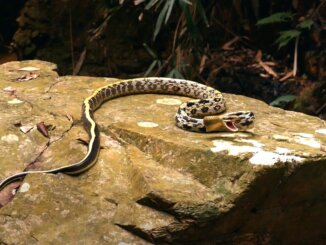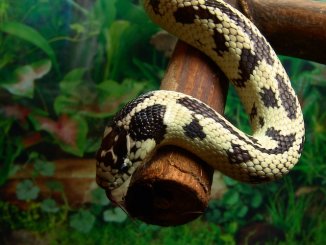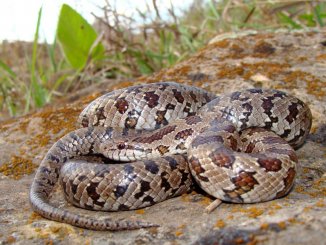Are you interested in a pet snake that eats insects and worms instead of mice or rats? The rough green snake may be the best fit for you. What’s more, it does not need a lot of space as it is small and slender.
The rough green snake (Opheodrys aestivus) is a non-venomous reptile native to North America. Other names include the keeled green snake, grass snake, and vine snake.
Its long, slender green body allows it to camouflage in leafy trees and the vegetated regions of Southeastern United States.
Every year, hundreds of rough green snakes are collected from nature and sold in pet stores across the country.
Thus, these pets are widely available to reptile keepers. However, the number of rough green snakes is endangered in many states.
Rough green snakes are popular among experienced reptile keepers since they are pretty shy. You need a quiet habitat for the reptile to thrive, and they can get stressed by handling.
This article discusses how to care for the snake, its feeding habits, ideal habitat, behavior, and additional facts.
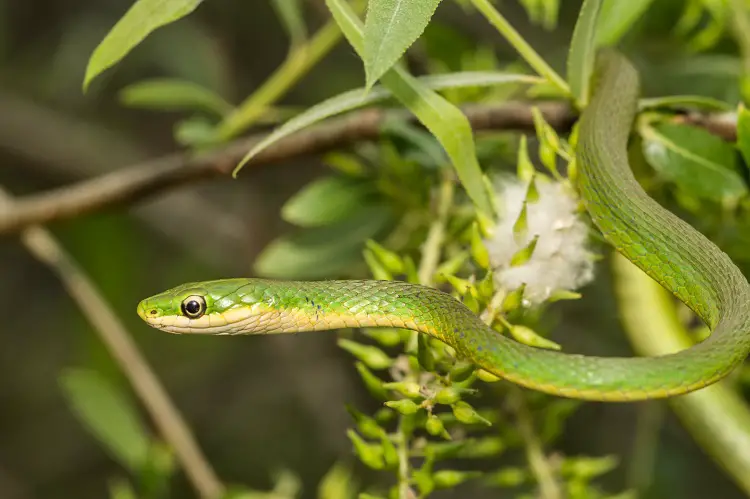
Rough Green Snake Overview
The rough green snake belongs to the Colubridae family and is named for its color. It is one of the North American green snakes, with the other being the smooth green snakes.
Smooth green snakes are typically less slender and smaller with smooth scales. Also included in this family are the African green snakes and other species in southern and eastern Asia.
The snake’s first scientific description was written by the reputed naturalist Carl Linnaeus appeared in 1766. It is arboreal in nature and is rarely seen on the ground.
Instead, it hangs on to twigs and branches in its hunt for insects. The snake is mild-tempered and will rarely strike or bite.
The rough green snake commonly hibernates in underground tunnels in cold, winter tunnels. However, it may avoid hibernation altogether if the winter is mild.
Also, high mortality rates may occur if the winter sets in suddenly before the snakes can prepare hibernation tunnels.
The surviving snakes emerge in April to feed and mate.
Rough Green Snake’s Appearance
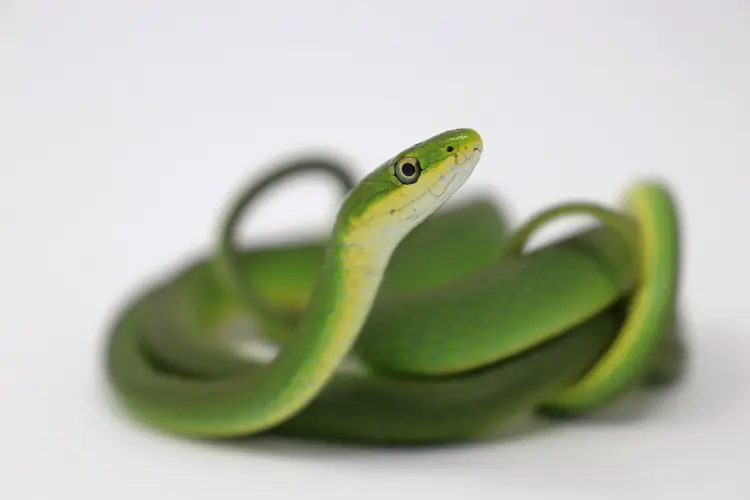
The rough green snake is fittingly named for its keeled scales that result in a texture appearance. The scales enable the reptile to climb through dense branches.
It is bright green above with a milky yellow, pale green, or white underbelly and a white chin. However, younger snakes have dull skin, which they shed off for a brighter coat.
The snake’s green body provides excellent camouflage in vegetation.
It is a long, slender snake that grows to 20-32 inches, although some adults reach 45 inches.
The female rough green snakes are slightly larger than the males, but the males have longer tails. The reptile also has large eyes, which enhance its vision among dense vegetation.
Natural Habitat of the Rough Green Snake
The rough green snake abounds among leafy trees, moist meadows, and woodlands near water in the wild. They travel along the edges of rivers and wetlands and catch insects from overhanging vegetation.
The snake can also take to the water when chasing prey.
Adult green rough snakes have been found in suburban neighborhoods, in areas where urbanization encroaches on suitable habitats.
In fact, it is common to see them around road edges, backyards, and other disturbed areas. At night, the snake sleeps coiled around shrubs and vines.
It is most active during the day, where it forages and hunts for live invertebrates.
The snake’s populations are widespread across eastern and southeastern United States, from southeastern New Jersey, eastern Kansas, central Texas, and Florida.
It is also present in the Coastal Plain and Piedmont but absent from the mountains’ higher elevation.
Care Guide
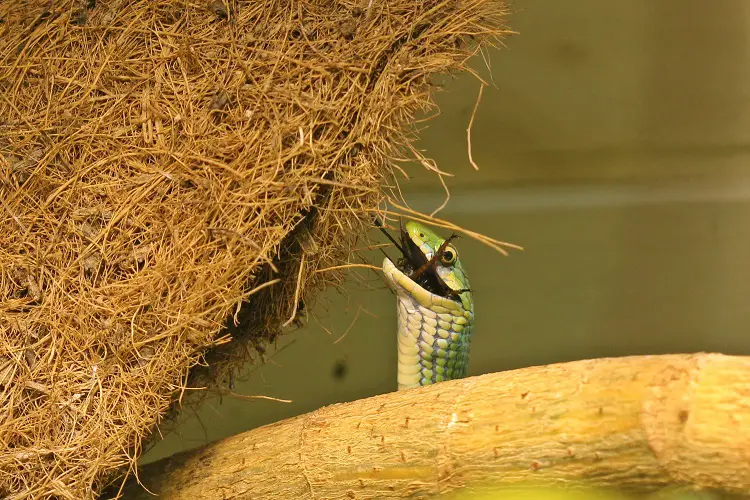
The snake is notoriously flighty, and you want to keep it in a locked enclosure. You will enjoy watching this beautiful reptile during the day when it is most active, although you should ease up on the handling.
You may have heard that rough green snakes are easy to look after, but it requires high-quality care. One of the most important care tips to remember is that the snake responds poorly to a cold or damp environment.
Some signs of a healthy rough green snake include:
- Feeds regularly
- Agile and alert
- mite- and tick-free
- sheds skin frequently in one complete piece
Habitat Setup
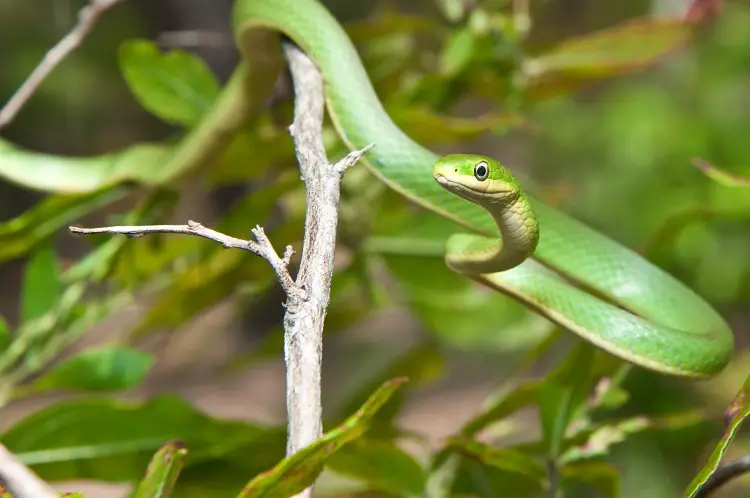
There are several aspects to observe when setting up a rough green snake’s habitat, including:
Housing
Rough green snakes flourish in spacious enclosures where they can move around. An adult will be comfortable in a 20-gallon tank, and hatchlings require at least a 10-gallon enclosure.
The snake needs a lot of vertical space, making hexagonal tanks particularly ideal. Use either glass or plastic enclosures instead of wood since damp wood can harbor bacteria and mold.
Rough green snakes are social and cool-tempered, and you can have a few of them in one large tank. However, do not house different species of green snakes together.
Use a sturdy and secure screen lid to prevent your pet from escaping. Screen tops allow for ventilation and protect your pet from respiratory problems.
Also, clamped-down lids work best as the snakes have thin bodies that can slither through tiny spaces.
Furnish the enclosure with climbing structures since the reptile is an active climber. Also, include hide boxes, non-toxic live plants like pothos, and foliage.
If you prefer artificial foliage, use silk plants as they are easy to clean. Rough green snakes get stressed if there is not sufficient greenery to hide, which is why you should provide branches and vines.
Indeed, greenery should occupy 50% of the tank’s space.
It is vital to keep the rough snake’s enclosure clean. Replace any wet bedding resulting from a spilled water bowl and clean up any visible poop.
Take out everything in the tank and clean it every week as you also replace the substrate.
Substrate
You need a substrate that holds moisture well but resists mold and fungal growth. Ideal beddings include coconut fiber, sphagnum moss, aspen shavings, cypress mulch, and orchid bark.
Paper towels and inkless newspapers are great alternatives if you want bedding that is easy to clean.
However, ensure that the floor is not too cluttered as the snake likes to slither around quickly and avoid bedding that the snake can ingest.
Also, spot clean the substrate once a day to remove fecal matter and maintain a healthy environment.
Temperature
The rough green snake, like many snakes, requires two different temperatures on opposite ends of the enclosure. Use a heat lamp or a basking light on one end to raise the temperature to around 90 degrees Fahrenheit.
The temperatures on the cool side should be between 75-85 degrees Fahrenheit, and you can use a heated mat or heat bulb. While night temperatures can drop to 70 degrees, ensure they don’t fall beyond that.
It is advisable to install thermometers on either side of the tank to monitor the temperature. Since the snakes spend most of their time climbing, you place heating pads or tapes on the wall.
However, these solutions can burn your pet and are best suited for experienced reptile keepers. Additionally, place hiding spots at each corner to enable the snake to hide when regulating body temperature.
Lighting
A standard day/night cycle is necessary for this diurnal reptile to maintain a natural rhythm. Thus, set the lights on timers and choose full-spectrum lights that illuminate the entire tank.
You can also install a UV light to ensure the snake receives sufficient UVB rays. Finally, ensure the pets receive 12 to 14 hours of light every day.
Humidity
In the wild, rough green snakes gravitate towards moist meadows and pools of water. Invest in a hygrometer to ensure that your tank’s humidity levels stay between 55-65%.
You can boost the humidity levels by placing a large bowl of water in the tank, using live plants, or spraying water every day. However, ensure that the bedding is not continually wet to discourage bacterial or fungal growth.
What to Feed Rough Green Snakes
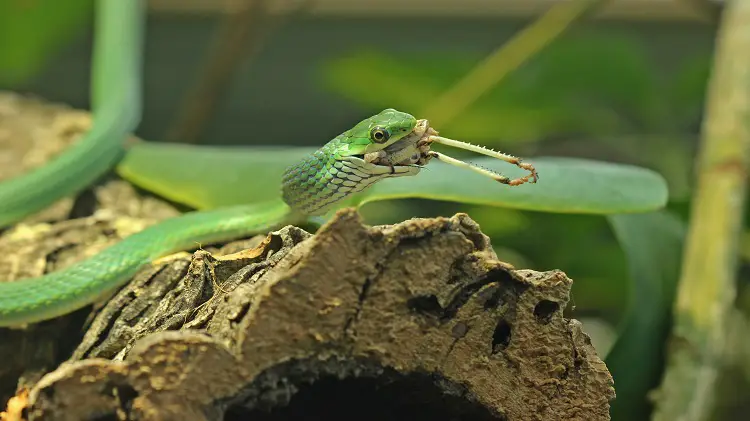
Wild rough green snakes primarily eat insects but also snails and small frogs. The snake stalks its prey, grasps it quickly, and swallows live prey head first.
It is essential to give the rough green snake a varied diet of soft-bodied insects like crickets, spiders, flies, caterpillars, and grasshoppers.
Provide half a dozen or fewer prey items at every feeding, depending on how active your pet is. Feed your pet twice or thrice a week, and give food that they can eat in around 20 minutes. Then, remove any uneaten food.
Although the snake likes chasing prey, live prey can cause stress and injury. Thus, dead insects are preferable.
Also, keep in mind that rough green snakes do not chew their food, and you should avoid prey items that are wider than the reptile’s body.
You can offer freshly molted mealworms, but only occasionally as they can cause impaction.
The insects should be gut-loaded, where they are fed nutritious meals and mineral and vitamin supplements before being given to the snakes.
Additionally, the feeder items should be dusted with calcium and multivitamin supplements a few times a week. These supplements come in powder form and stick to an insect’s coat to enhance their nutritional value.
Start hatchlings on a diet of pinhead crickets and fruit flies and gradually increase the feeder items’ size. When you first get your pet, use tongs as they can accidentally bite you if you offer up food on your hand.
Hand feeding may take time, but it will be worth it.
Rough green snakes lap up water from leaves and will rarely drink from a water bowl. However, it loves soaking in water to cool off and shed, and you should fill a sturdy bowl with chlorine-free water and place it in the tank.
The bowl should be too light as the snake can tip it over, and it should be too deep for the reptile to drown. Moreover, it should not be porous to avoid water leaking into the substrate.
Place the bowl on the tank’s cooler side to discourage rapid evaporation, which would raise the humidity to fatal levels.
Further, replace the water daily as the snake will get ill from ingesting fecal matter. Also, scrub the bowl every week to prevent the growth of fungi or mold.
Mist the greenery every day to ensure your pet gets sufficient water.
Green Rough Snake Behavior
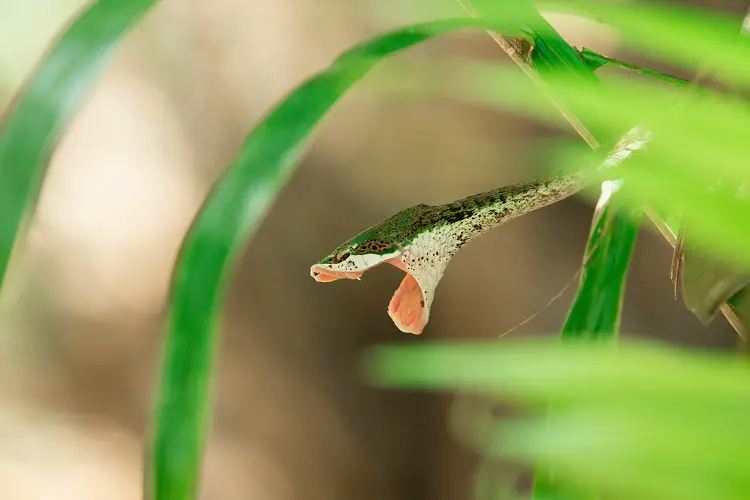
The rough green snake is docile and gentle and will rarely bite humans. In fact, some reptile keepers simply catch these snakes from the wild.
However, some regions have made it illegal to hunt these reptiles, and you should look up your state’s laws on their capture.
When you first bring your rough green snake home, it may act aggressively when you open the tank. This phenomenon is called “cage aggression,” common among rough green snakes in a new environment.
Some reptile keepers mistake this for hostility, but the snake just needs time to adjust.
If you want a snake that you can handle, the rough green snake will disappoint you at first. Indeed, some never get used to handling.
However, they may get used to you and won’t mind occasional handling. To start, try and touch the snake when it is in its house and monitor its reaction. Over time, they get curious and approach humans.
If they open their mouths wide, retreat as this is how they react when threatened. If they welcome your touch, don’t hold them by the tail. Also, the snake rarely sits still and is easy to lose.
The snakes spend most of their time climbing and hiding. Thus, it is essential to provide a lush environment with climbing structures and hiding spots.
Indeed, you may only see your pet during feeding or soaking in a water bowl. When you offer a prey item, the snake moves in a swaying motion that mimics the movement of a tree branch or vine in the wind.
Is the Rough Green Snake Safe to Handle?
Rough green snakes are not poisonous or venomous, and they hardly bite humans. Thus, they are ideal for reptile keepers who want a gentle snake to keep. If they do bite, there is little cause for alarm as the bite is harmless.
However, they let off a pungent smell if threatened, which can stay on your hands for a while. You can wear gloves when you handle the snake to protect your hands if it bites.
Also, bring it close to your body during handling, and don’t let it hang loosely.
Cost
The rough green snake is widely available across pet stores in the US, at an average of $8 each wholesale. It is advisable to buy captive-bred species as wild-caught specimens get stressed in captivity.
Moreover, wild-caught rough green snakes often carry a lot of parasites.
Lifespan and Health Issues
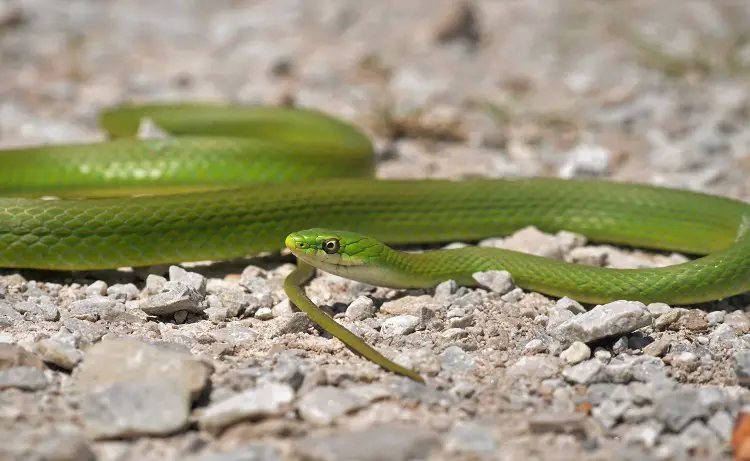
If you get a young rough green snake, it can live for up to 15 years. In fact, some specimens have lived up to 22 years. However, wild-caught specimens have shorter lives due to health problems caused by parasites.
Although rough green snakes are quite robust, they are vulnerable to respiratory illnesses. These infections occur when humidity levels exceed 65%, where the snake breathes through the mouth and discharge appears from the nose.
If this occurs, take the pet to a vet.
Mouth rot is another typical health concern caused by a weak immune system. It appears as inflammation and saliva bubbles around the mouth.
If left unchecked, the snake can lose its teeth when the infection affects the bone.
Rough green snakes are also susceptible to bacterial and fungal infections resulting from an unhealthy environment. However, you can protect the snake from all these health issues by maintaining a clean habitat with the correct temperature and humidity.
Facts
- The rough green snake is highly arboreal and spends most of its time climbing small trees, vines, and bushes.
- They are also called vine snakes, garden snakes, and grass snakes
- The rough green snake is listed as “Least Concern” by the IUCN, but its population is under threat from urbanization.
- It is exploited in the pet trade as hundreds of them are caught in the wild every year. Thus, it is advisable to get your rough green snake from a reputable breeder.
In Summary
If you are looking for a non-venomous snake that is interesting to watch, the rough green snake is a suitable pet. Since it is pretty long at 20-32 inches, you need at least a 20-gallon tank for a single specimen.
Ensure the enclosure has a lot of vertical space and furnish it with greenery as it is an enthusiastic climber. Set the tank’s lights on a timer since the snakes require 12 to 14 hours of light every day.
The snake primarily feeds on insects twice to thrice a week. Finally, the rough green snake will be stressed by frequent handling, and you should give the pet time to adjust to your touch.

